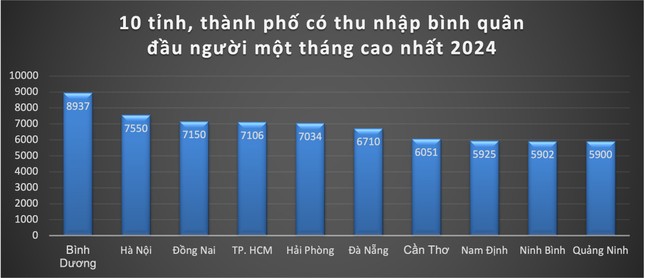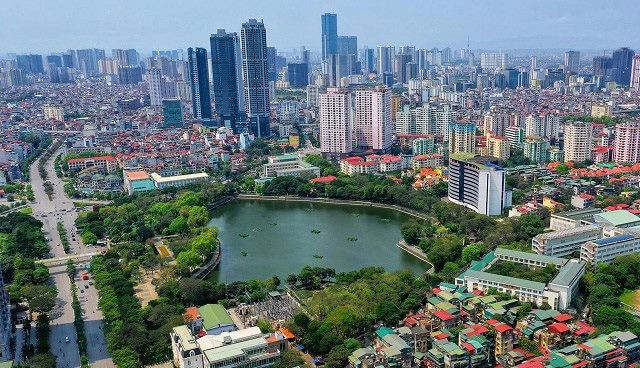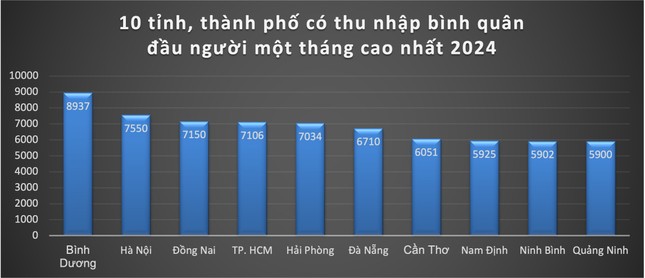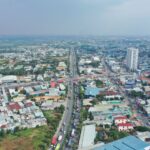Vietnam’s General Statistics Office under the Ministry of Finance has released the results of its 2024 household living standards survey. The average monthly income per capita in Vietnam reached VND 5.4 million, a 9.1% increase from 2023.
In urban areas, the average income was VND 6.9 million, 1.5 times higher than in rural areas, where it stood at VND 4.5 million. The Southeast region maintained its lead nationwide with an average income of nearly VND 7.1 million per person per month. In contrast, the Mid-Northern Mountainous region had the lowest income, at approximately VND 3.8 million.
2024 marks the final year of statistics based on the 63 provinces and cities before the implementation of the merger to 34 administrative units. Prior to this, Binh Duong province boasted the highest per capita income in the country at VND 8.9 million. Hanoi ranked second with VND 7.5 million, followed by Dong Nai (VND 7.15 million), Ho Chi Minh City (VND 7.1 million), and Hai Phong (over VND 7 million).

The 10 provinces/cities with the highest per capita monthly income in 2024 (in thousands of VND)
The top 10 provinces/cities with the highest income also included Da Nang, Can Tho, Nam Dinh, Ninh Binh, and Quang Ninh. Notably, Ninh Binh and Quang Ninh are new entrants compared to 2023, replacing Vinh Phuc and Hai Duong.
On the other hand, 40 provinces/cities had income levels below the national average. Dien Bien province had the lowest income at VND 2.38 million per person per month. Several other provinces, including Ha Giang, Son La, Lai Chau, Cao Bang, and Bac Kan, also reported incomes below VND 3 million.
According to the General Statistics Office, in 2024, the average income of the population continued to improve, increasing in both urban and rural areas. Despite the complex and unpredictable global situation, Vietnam’s socio-economic achievements led to improved living standards for its citizens.
Household spending in 2024 rebounded, mainly in urban areas. On average, each person spent nearly VND 3 million per month. Urban residents spent around VND 3.8 million, while rural residents spent approximately VND 2.5 million.
Expenditure on living standards accounted for 94.5% of total household spending, equivalent to VND 2.8 million per person per month. The highest-income group spent over VND 4.5 million, 3.1 times higher than the lowest-income group, which spent nearly VND 1.5 million per month.
According to the 2024 SCOLI (Standard of Living Index) survey results, Hanoi continued to be the locality with the highest consumer prices in the country.

Quang Ninh ranked second with prices comparable to Hanoi (SCOLI index of 99.94% of Hanoi). Some commodity groups in Quang Ninh, such as medical services, housing, and consumer goods, were more expensive than in Hanoi, while others like culture, transportation, and apparel were lower. Quang Ninh is a northern economic, tourism, and gateway hub.
Ho Chi Minh City came in third, with a SCOLI index of 99.8%. Some commodity groups in the city were cheaper than in Hanoi, such as apparel, food and beverage, and entertainment, while others like education, telecommunications, beverages, and housing were more expensive. The high spending corresponds to the high average income in this locality.
Hai Phong ranked fourth (98.43%) and Da Nang fifth (98.21%). Despite their high average incomes and prominent tourism industries, prices for goods and services in these cities remained significantly lower than in Hanoi and Ho Chi Minh City due to their proximity to the sea and abundant, reasonably priced food sources.
Compared to 2023, the list of localities with the highest prices remained largely unchanged. Big cities continued to have noticeably higher living costs than mountainous and rural areas, especially in education, housing, and entertainment services.
On the other end of the spectrum, Quang Tri province had the lowest cost of living in 2024. The local economy relies mainly on agriculture, forestry, and fisheries, resulting in lower food and basic service prices.
Ben Tre ranked second, followed by Quang Ngai, Ca Mau, Nam Dinh, Nghe An, Tra Vinh, Gia Lai, Long An, Soc Trang, and Phu Tho. These provinces shared common characteristics of lower costs in food, apparel, rental housing, education, and entertainment.
“Vietnam-US Bilateral Trade Talks: Positive Outcomes and the Road Ahead for June 2025”
The second round of negotiations for the Bilateral Reciprocal Trade Agreement between Vietnam and the United States took place from May 19 to 22, 2025, in Washington, D.C. This highly anticipated event marked a significant step forward in strengthening the economic relationship between the two nations.
“Vietnam: A Strategic and Alluring Market for US Businesses.”
U.S. Secretary of Commerce, Howard Lutnick, emphasized the significance of Vietnam as an attractive and important market for American businesses. He expressed his desire for Vietnam to continue facilitating investment projects from the United States, thereby expanding bilateral trade, particularly in terms of importing goods from America.
The Highest-Earning Province in the Country is Unveiled: A Sneak Peek at the Upcoming Merger
According to the General Statistics Office, the average monthly income per capita in urban areas reached 6.9 million VND in 2024, marking a significant milestone in Vietnam’s economic development.





















